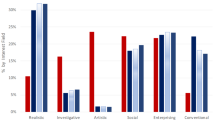Abstract
High turnover and short tenures are the norm for state university presidents in the last part of the twentieth century. Depending on the type of institution, the average state university president stays in office about four years, some three years shorter than the national average of seven years for all higher education institutions. The article discusses this trend and relates length of tenure to the formal and informal evaluations of presidents. Beginning with a presentation of presidential tenure (time in office) data and a discussion of the benefits of longer terms, the article continues with a dialogue on the role of the president in state institutions of higher education. It is argued that the position of president necessitates constituent leadership with presidents often expected to please all constituencies. Included in this discussion are the nature, role, and effectiveness of evaluations of university presidents. The authors conclude that evaluations of presidents make little difference in decisions to retain or remove presidents. Even a good or great evaluation does not offset the impact of the unforseen event or changes in political leadership within a state or on a board. The authors agree that annual reviews or reports are valuable in improving a president’s performance and leadership. Evaluations make a difference when they are supervised by individuals with direct knowledge of the job, are fair in terms of expectations from often divergent constituent groups, and focus on maximizing the ability of the president to improve the institution.
Similar content being viewed by others
References
Association of Governing Boards of Universities and Colleges. (1984). Presidents make a difference: Strengthening leadership in colleges and universities. A report of the commission on strengthening presidential leadership. Directed by Clark Kerr. Washington, DC: Author.
Birnbaum, R. (1993). Why presidents succeed and fail. Trusteeship, Association of Governing Boards of State Colleges and Universities, 16–21.
Cohen, M.D., & Marsh, J.G. (1974). Leadership and ambiguity: The American college president. New York: McGraw-Hill.
Cowley, William H. (1980). Presidents, professors, and trustees. ed. Donald T. Williams, Jr. San Francisco: Jossey-Bass.
Davis, W.E. (1981). The brevity and longevity. NASULGC: The Green Sheet, 1–8.
Davis, W.E. (1982). Average tenure of college and university presidents, Unpublished manuscript.
Davis, W.E. (1984). Ghosts of NASULGC past. NASULGC: The Green Sheet, 1–5.
Davis,W.E. (1988). That revolving door is breaking up that old gang of mine. NASULGC: The Green Sheet, 1–4.
Davis, W.E. (1991a). The wind of change: Presidential tenure, 1990. Part I. NASULGC: The Green Sheet, 39–45.
Davis, W.E. (1991b). The wind of change: Presidential tenure, 1990. Part II. NASULGC: The Green Sheet, 54–67.
Davis, W.E. (1997). NASULGC presidents—1997—don't hang around much anymore. Unpublished manuscript. Selected information and tables published in NASULGC presidential tenures growing shorter, 1998, March. NASULGC Newsline, 7(5), 9–10. http://www.nasulgc.nche.edu./BudDavis6.htm.
Fujita, E. (1994). A good college president: The constituent point of view. Journal of Personnel Evaluation in Education, 8(1), 75–91.
Hutchins, R.M. (1956). Freedom, education, and the fund: Essays and addresses, 1946–1956. New York: Meridian Books.
Kerr, C. (1994). Troubled time for American higher education: The 1990s and beyond. Albany: State University of New York Press.
Kerr, C. & Gade, M.L. (1986). The many lives of academic presidents: Time, place and character. Washington, DC: Association of Governing Boards of Universities and Colleges.
Minutes of the Oregon State Board of Higher Education. (1982). April 12.
National Association of State Universities and Land Grant Colleges (NASULGC). (1980–1997). Membership Lists.
National Beta Club. (1980–1997). College facts chart. (27th–41st eds.). Spartanburg, SC: Author.
Ogilvy, J.D.A. (1963). The problems of a president. Colorado Quarterly, (Summer), 55–63.
Simon, H.A. (1967). The job of a college president. Educational Record, 48(1), 68.
Author information
Authors and Affiliations
Rights and permissions
About this article
Cite this article
Davis, W.E., Davis, D.R. The University Presidency: Do Evaluations Make a Difference?. Journal of Personnel Evaluation in Education 13, 119–140 (1999). https://doi.org/10.1023/A:1008160219466
Issue Date:
DOI: https://doi.org/10.1023/A:1008160219466




